Evaluation of Global Fraction of Absorbed Photosynthetically Active Radiation (FAPAR) Products at 500 m Spatial Resolution
Abstract
:1. Introduction
2. Materials and Methods
2.1. Data
2.1.1. MUSES FAPAR Product
2.1.2. EBR FAPAR Product
2.1.3. MODIS FAPAR Product
2.1.4. High-Resolution FAPAR Reference Maps
2.2. Methods
2.2.1. Spatial and Temporal Consistency Analysis
2.2.2. Direct Validation
3. Results
3.1. Spatial Consistency
3.2. Temporal Consistency
3.3. Direct Validation
4. Discussion
5. Conclusions
Author Contributions
Funding
Acknowledgments
Conflicts of Interest
References
- Gower, S.T.; Kucharik, C.J.; Norman, J.M. Direct and Indirect Estimation of Leaf Area Index, fAPAR, and Net Primary Production of Terrestrial Ecosystems. Remote Sens. Environ. 1999, 70, 29–51. [Google Scholar] [CrossRef]
- Secretariat, G. Systematic observation requirements for satellite-based products for climate. In GCOS Implementation Plan; GCOS Secretariat: Geneva, Switzerland, 2006. [Google Scholar]
- Kaminski, T.; Knorr, W.; Scholze, M.; Gobron, N.; Pinty, B.; Giering, R.; Mathieu, P.P. Consistent assimilation of MERIS FAPAR and atmospheric CO2 into a terrestrial vegetation model and interactive mission benefit analysis. Biogeosciences 2012, 9, 3173–3184. [Google Scholar] [CrossRef] [Green Version]
- Maselli, F.; Chiesi, M.; Fibbi, L.; Moriondo, M. Integration of remote sensing and ecosystem modelling techniques to estimate forest net carbon uptake. Int. J. Remote Sens. 2008, 29, 2437–2443. [Google Scholar] [CrossRef]
- Prince, S.D.; Goward, S.N. Global Primary Production: A Remote Sensing Approach. J. Biogeogr. 1995, 22, 815–835. [Google Scholar] [CrossRef]
- Running, S.W.; Nemani, R.R.; Heinsch, F.A.; Zhao, M.; Reeves, M.; Hashimoto, H. A Continuous Satellite-Derived Measure of Global Terrestrial Primary Production. Bioscience 2004, 54, 547–560. [Google Scholar] [CrossRef]
- Rayner, P.J.; Scholze, M.; Knorr, W.; Kaminski, T.; Giering, R.; Widmann, H. Two decades of terrestrial carbon fluxes from a carbon cycle data assimilation system (CCDAS). Glob. Biogeochem. Cycles 2005, 19, GB2026. [Google Scholar] [CrossRef] [Green Version]
- Gobron, N.; Pinty, B.; Mélin, F.; Taberner, M.; Verstraete, M.M.; Belward, A.; Lavergne, T.; Widlowski, J.L. The state of vegetation in Europe following the 2003 drought. Int. J. Remote Sens. 2005, 26, 2013–2020. [Google Scholar] [CrossRef]
- Gonsamo, A.; Chen, J.M.; Price, D.T.; Kurz, W.A.; Wu, C. Land surface phenology from optical satellite measurement and CO2 eddy covariance technique. J. Geophys. Res. Biogeosci. 2012, 117, G03032. [Google Scholar] [CrossRef]
- Verstraete, M.M.; Gobron, N.; Aussedat, O.; Robustelli, M.; Pinty, B.; Widlowski, J.-L.; Taberner, M. An automatic procedure to identify key vegetation phenology events using the JRC-FAPAR products. Adv. Space Res. 2008, 41, 1773–1783. [Google Scholar] [CrossRef]
- Myneni, R.B.; Hoffman, S.; Knyazikhin, Y.; Privette, J.L.; Glassy, J.; Tian, Y.; Wang, Y.; Song, X.; Zhang, Y.; Smith, G.R.; et al. Global products of vegetation leaf area and fraction absorbed PAR from year one of MODIS data. Remote Sens. Environ. 2002, 83, 214–231. [Google Scholar] [CrossRef] [Green Version]
- Gobron, N.; Pinty, B.; Verstraete, M.; Govaerts, Y. The MERIS Global Vegetation Index (MGVI): Description and preliminary application. Int. J. Remote Sens. 1999, 20, 1917–1927. [Google Scholar] [CrossRef]
- Gobron, N.; Mélin, F.; Pinty, B.; Verstraete, M.M.; Widlowski, J.L.; Bucini, G. A global vegetation index for SeaWiFS: Design and applications. In Remote Sensing and Climate Modeling: Synergies and Limitations; Beniston, M., Verstraete, M.M., Eds.; Springer: Dordrecht, The Netherlands, 2001; pp. 5–21. [Google Scholar] [CrossRef]
- Baret, F.; Hagolle, O.; Geiger, B.; Bicheron, P.; Miras, B.; Huc, M.; Berthelot, B.; Niño, F.; Weiss, M.; Samain, O.; et al. LAI, fAPAR and fCover CYCLOPES global products derived from VEGETATION: Part 1: Principles of the algorithm. Remote Sens. Environ. 2007, 110, 275–286. [Google Scholar] [CrossRef] [Green Version]
- Baret, F.; Weiss, M.; Lacaze, R.; Camacho, F.; Makhmara, H.; Pacholcyzk, P.; Smets, B. GEOV1: LAI and FAPAR essential climate variables and FCOVER global time series capitalizing over existing products. Part 1: Principles of development and production. Remote Sens. Environ. 2013, 137, 299–309. [Google Scholar] [CrossRef]
- Knyazikhin, Y.; Martonchik, J.V.; Diner, D.J.; Myneni, R.B.; Verstraete, M.; Pinty, B.; Gobron, N. Estimation of vegetation canopy leaf area index and fraction of absorbed photosynthetically active radiation from atmosphere-corrected MISR data. J. Geophys. Res. Earth Surf. 1998, 103, 32239–32256. [Google Scholar] [CrossRef] [Green Version]
- Yang, B.; Knyazikhin, Y.; Mõttus, M.; Rautiainen, M.; Stenberg, P.; Yan, L.; Chen, C.; Yan, K.; Choi, S.; Park, T.; et al. Estimation of leaf area index and its sunlit portion from DSCOVR EPIC data: Theoretical basis. Remote Sens. Environ. 2017, 198, 69–84. [Google Scholar] [CrossRef] [Green Version]
- Knyazikhin, Y.; Song, W.; Yang, B.; Mõttus, M.; Rautiainen, M.; Park, T. Earth System Data Record from DSCOVR EPIC Observations: Product Description and Analyses; OpenBU: Boston, MA, USA, 2018. [Google Scholar]
- Liu, L.; Zhang, X.; Xie, S.; Liu, X.; Song, B.; Chen, S.; Peng, D. Global White-Sky and Black-Sky FAPAR Retrieval Using the Energy Balance Residual Method: Algorithm and Validation. Remote Sens. 2019, 11, 1004. [Google Scholar] [CrossRef] [Green Version]
- Xiao, Z.; Liang, S.; Sun, R.; Wang, J.; Jiang, B. Estimating the fraction of absorbed photosynthetically active radiation from the MODIS data based GLASS leaf area index product. Remote Sens. Environ. 2015, 171, 105–117. [Google Scholar] [CrossRef]
- Camacho, F.; Cernicharo, J.; Lacaze, R.; Baret, F.; Weiss, M. GEOV1: LAI, FAPAR essential climate variables and FCOVER global time series capitalizing over existing products. Part 2: Validation and intercomparison with reference products. Remote Sens. Environ. 2013, 137, 310–329. [Google Scholar] [CrossRef]
- Tao, X.; Liang, S.; Wang, D. Assessment of five global satellite products of fraction of absorbed photosynthetically active radiation: Intercomparison and direct validation against ground-based data. Remote Sens. Environ. 2015, 163, 270–285. [Google Scholar] [CrossRef]
- Weiss, M.; Baret, F.; Garrigues, S.; Lacaze, R. LAI and fAPAR CYCLOPES global products derived from VEGETATION. Part 2: Validation and comparison with MODIS collection 4 products. Remote Sens. Environ. 2007, 110, 317–331. [Google Scholar] [CrossRef]
- D’Odorico, P.; Gonsamo, A.; Pinty, B.; Gobron, N.; Coops, N.; Mendez, E.; Schaepman, M.E. Intercomparison of fraction of absorbed photosynthetically active radiation products derived from satellite data over Europe. Remote Sens. Environ. 2014, 142, 141–154. [Google Scholar] [CrossRef]
- Fensholt, R.; Sandholt, I.; Rasmussen, M.S. Evaluation of MODIS LAI, fAPAR and the relation between fAPAR and NDVI in a semi-arid environment using in situ measurements. Remote Sens. Environ. 2004, 91, 490–507. [Google Scholar] [CrossRef]
- Martínez, B.; Camacho, F.; Verger, A.; García-Haro, F.J.; Gilabert, M.A. Intercomparison and quality assessment of MERIS, MODIS and SEVIRI FAPAR products over the Iberian Peninsula. Int. J. Appl. Earth Obs. Geoinf. 2013, 21, 463–476. [Google Scholar] [CrossRef]
- McCallum, I.; Wagner, W.; Schmullius, C.; Shvidenko, A.; Obersteiner, M.; Fritz, S.; Nilsson, S. Comparison of four global FAPAR datasets over Northern Eurasia for the year 2000. Remote Sens. Environ. 2010, 114, 941–949. [Google Scholar] [CrossRef]
- Meroni, M.; Atzberger, C.; Vancutsem, C.; Gobron, N.; Baret, F.; Lacaze, R.; Eerens, H.; Leo, O. Evaluation of Agreement Between Space Remote Sensing SPOT-VEGETATION fAPAR Time Series. IEEE Trans. Geosci. Remote Sens. 2013, 51, 1951–1962. [Google Scholar] [CrossRef]
- Pinty, B.; Clerici, M.; Andredakis, I.; Kaminski, T.; Taberner, M.; Verstraete, M.M.; Gobron, N.; Plummer, S.; Widlowski, J.L. Exploiting the MODIS albedos with the Two-stream Inversion Package (JRC-TIP): 2. Fractions of transmitted and absorbed fluxes in the vegetation and soil layers. J. Geophys. Res. Earth Surf. 2011, 116, D09106. [Google Scholar] [CrossRef] [Green Version]
- Knyazikhin, Y.; Martonchik, J.V.; Myneni, R.B.; Diner, D.J.; Running, S.W. Synergistic algorithm for estimating vegetation canopy leaf area index and fraction of absorbed photosynthetically active radiation from MODIS and MISR data. J. Geophys. Res. Earth Surf. 1998, 103, 32257–32275. [Google Scholar] [CrossRef] [Green Version]
- Claverie, M.; Vermote, E.F.; Weiss, M.; Baret, F.; Hagolle, O.; Demarez, V. Validation of coarse spatial resolution LAI and FAPAR time series over cropland in southwest France. Remote Sens. Environ. 2013, 139, 216–230. [Google Scholar] [CrossRef]
- Serbin, S.P.; Ahl, D.E.; Gower, S.T. Spatial and temporal validation of the MODIS LAI and FPAR products across a boreal forest wildfire chronosequence. Remote Sens. Environ. 2013, 133, 71–84. [Google Scholar] [CrossRef]
- Jiao, Z.; Dong, Y.; Schaaf, C.B.; Chen, J.M.; Román, M.; Wang, Z.; Zhang, H.; Ding, A.; Erb, A.; Hill, M.J.; et al. An algorithm for the retrieval of the clumping index (CI) from the MODIS BRDF product using an adjusted version of the kernel-driven BRDF model. Remote Sens. Environ. 2018, 209, 594–611. [Google Scholar] [CrossRef]
- Myneni, R.; Knyazikhin, Y.; Park, T. MCD15A2H MODIS/Terra+Aqua Leaf Area Index/FPAR 8-day L4 Global 500m SIN Grid V006; [Data set]. 2015. Available online: https://lpdaac.usgs.gov/products/mcd15a2hv006/ (accessed on 10 May 2022).
- Wenze, Y.; Bin, T.; Dong, H.; Rautiainen, M.; Shabanov, N.V.; Wang, Y.; Privette, J.L.; Huemmrich, K.F.; Fensholt, R.; Sandholt, I.; et al. MODIS leaf area index products: From validation to algorithm improvement. IEEE Trans. Geosci. Remote Sens. 2006, 44, 1885–1898. [Google Scholar] [CrossRef]
- Mõttus, M.; Sulev, M.; Baret, F.; Lopez-Lozano, R.; Reinart, A. Photosynthetically active radiation: Measurement and modeling. In Solar Energy; Springer: New York, NY, USA, 2013; pp. 140–169. [Google Scholar]
- Morisette, J.T.; Baret, F.; Privette, J.L.; Myneni, R.B.; Nickeson, J.E.; Garrigues, S.; Shabanov, N.V.; Weiss, M.; Fernandes, R.A.; Leblanc, S.G.; et al. Validation of global moderate-resolution LAI products: A framework proposed within the CEOS land product validation subgroup. IEEE Trans. Geosci. Remote Sens. 2006, 44, 1804–1817. [Google Scholar] [CrossRef] [Green Version]
- Cao, R.; Shen, M.; Chen, J.; Tang, Y. A simple method to simulate diurnal courses of PAR absorbed by grassy canopy. Ecol. Indic. 2014, 46, 129–137. [Google Scholar] [CrossRef]
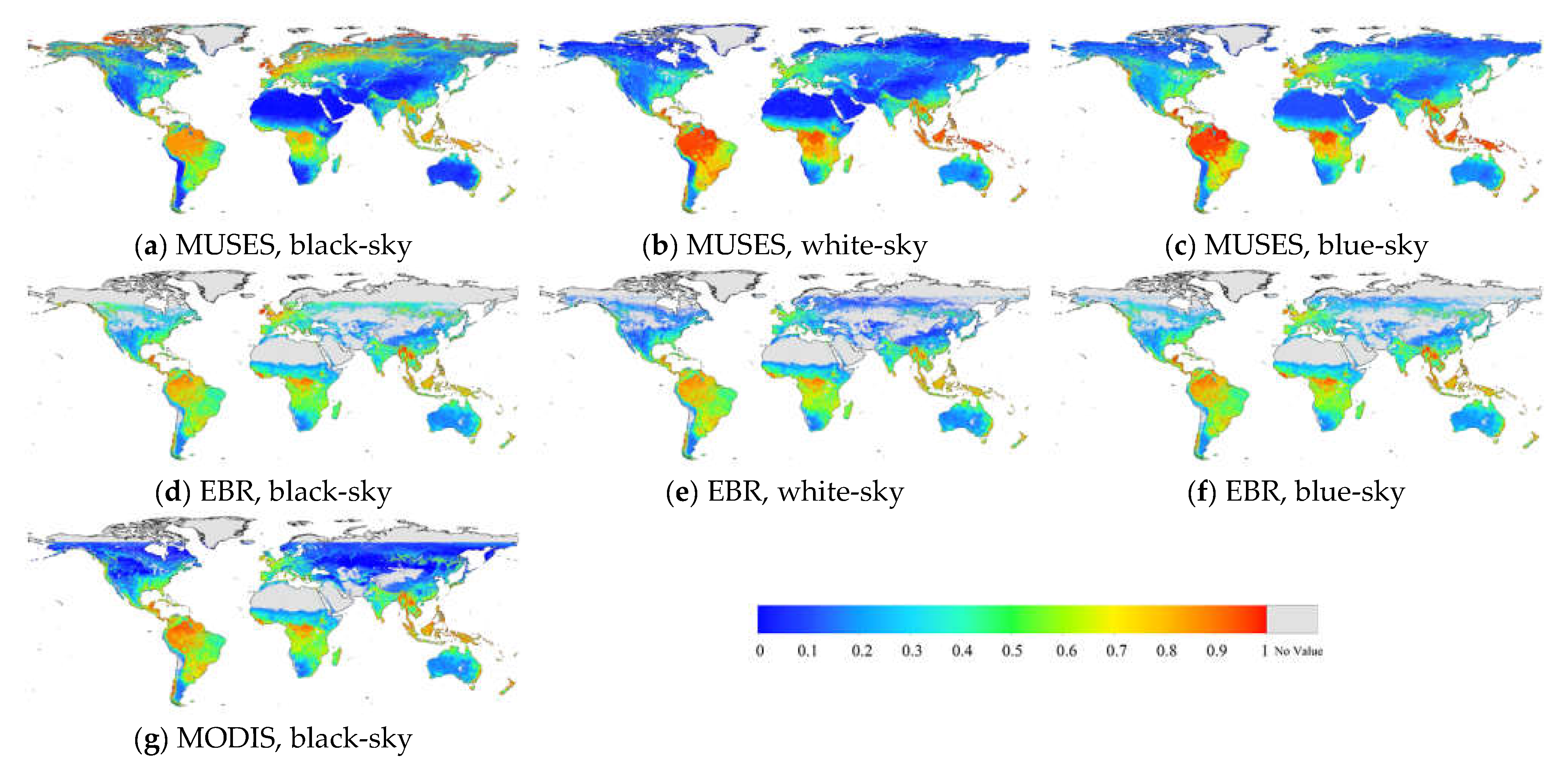
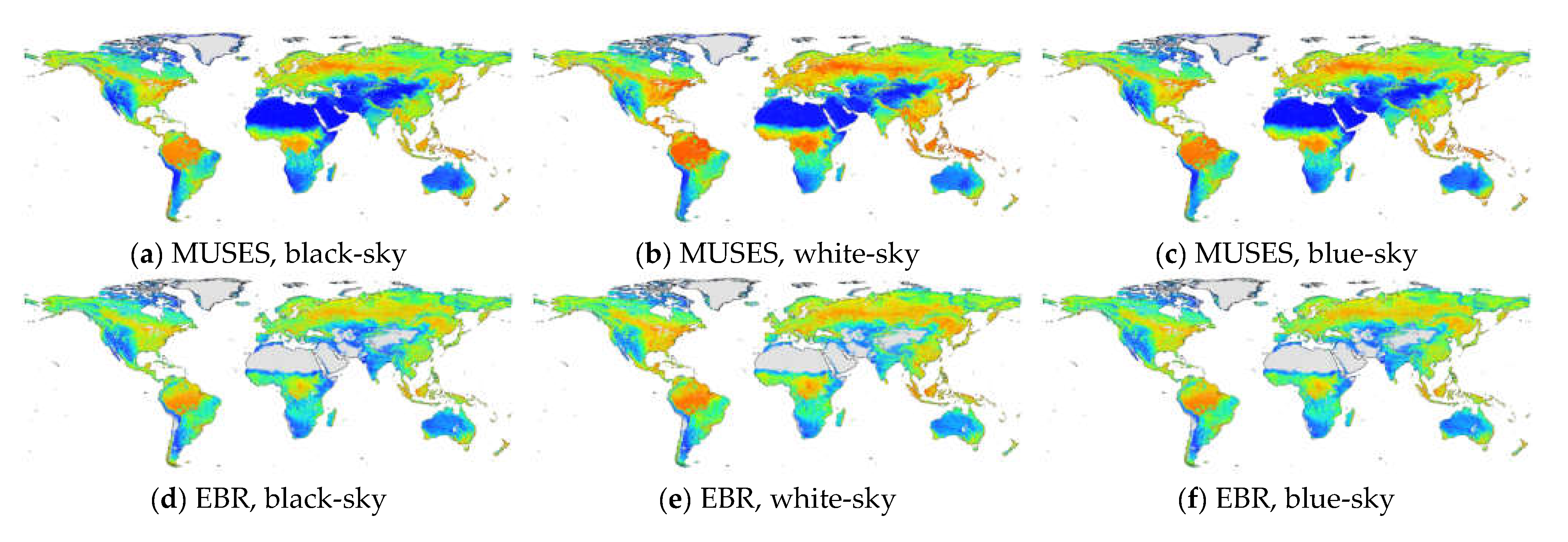

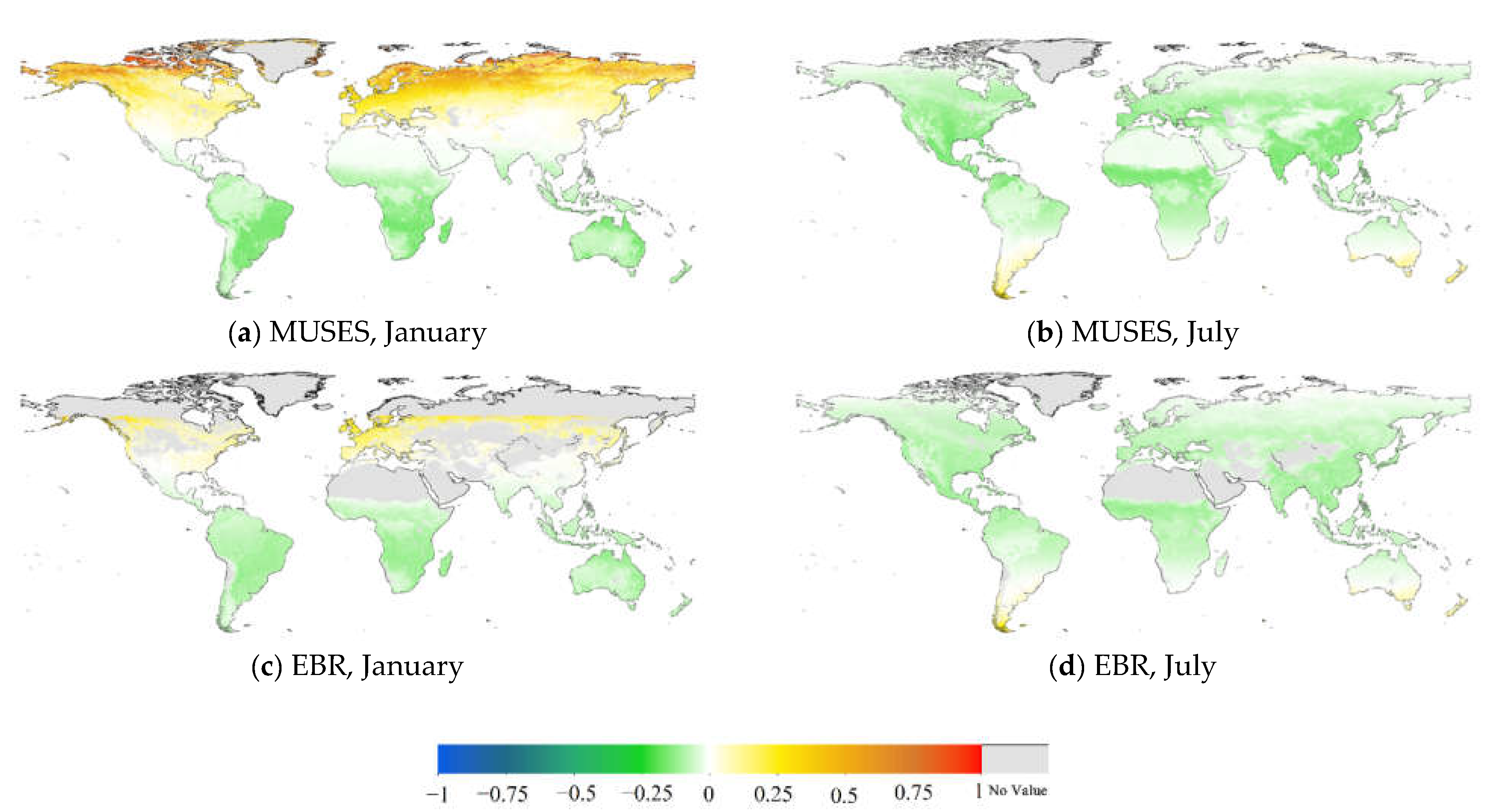
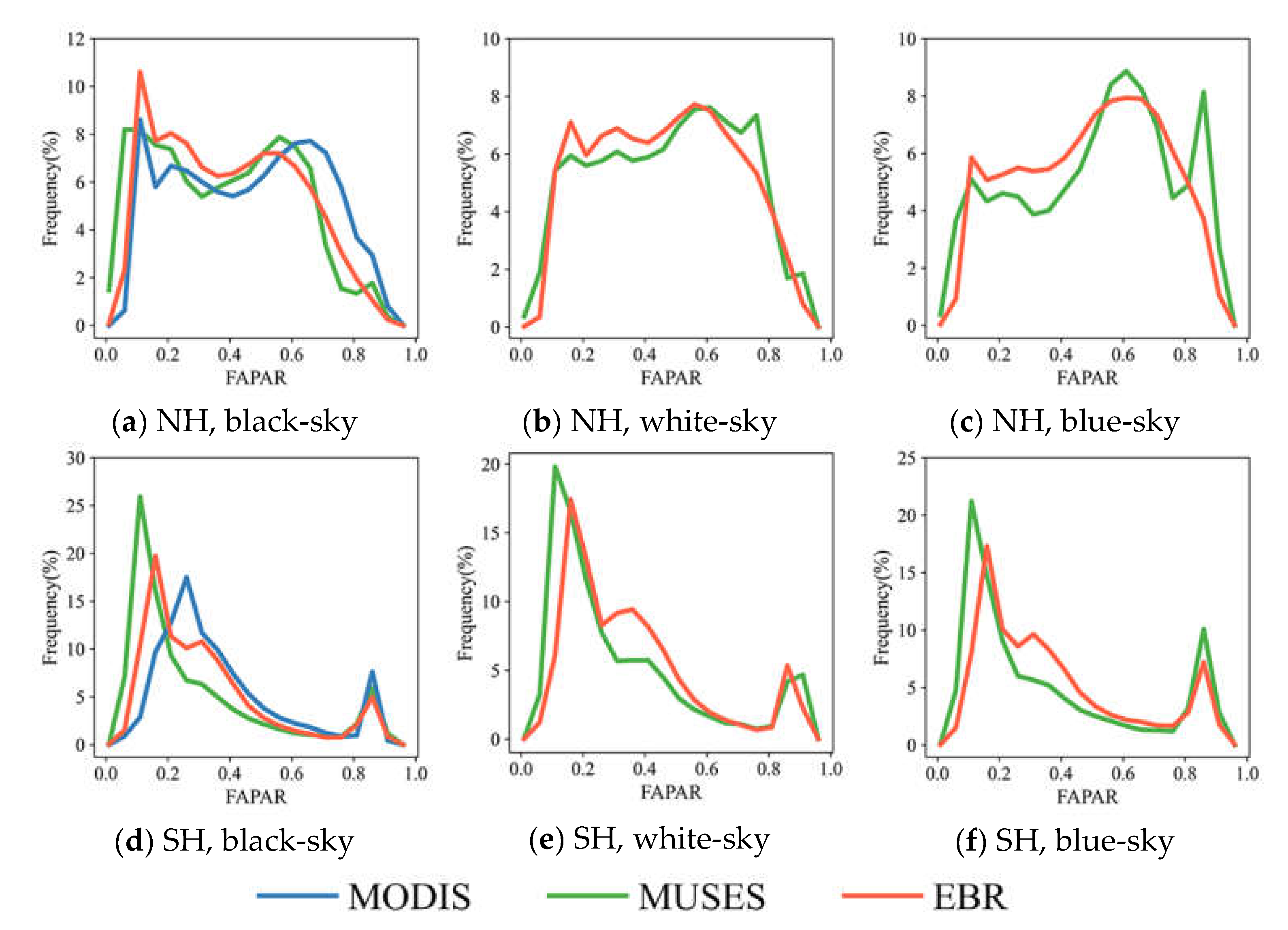

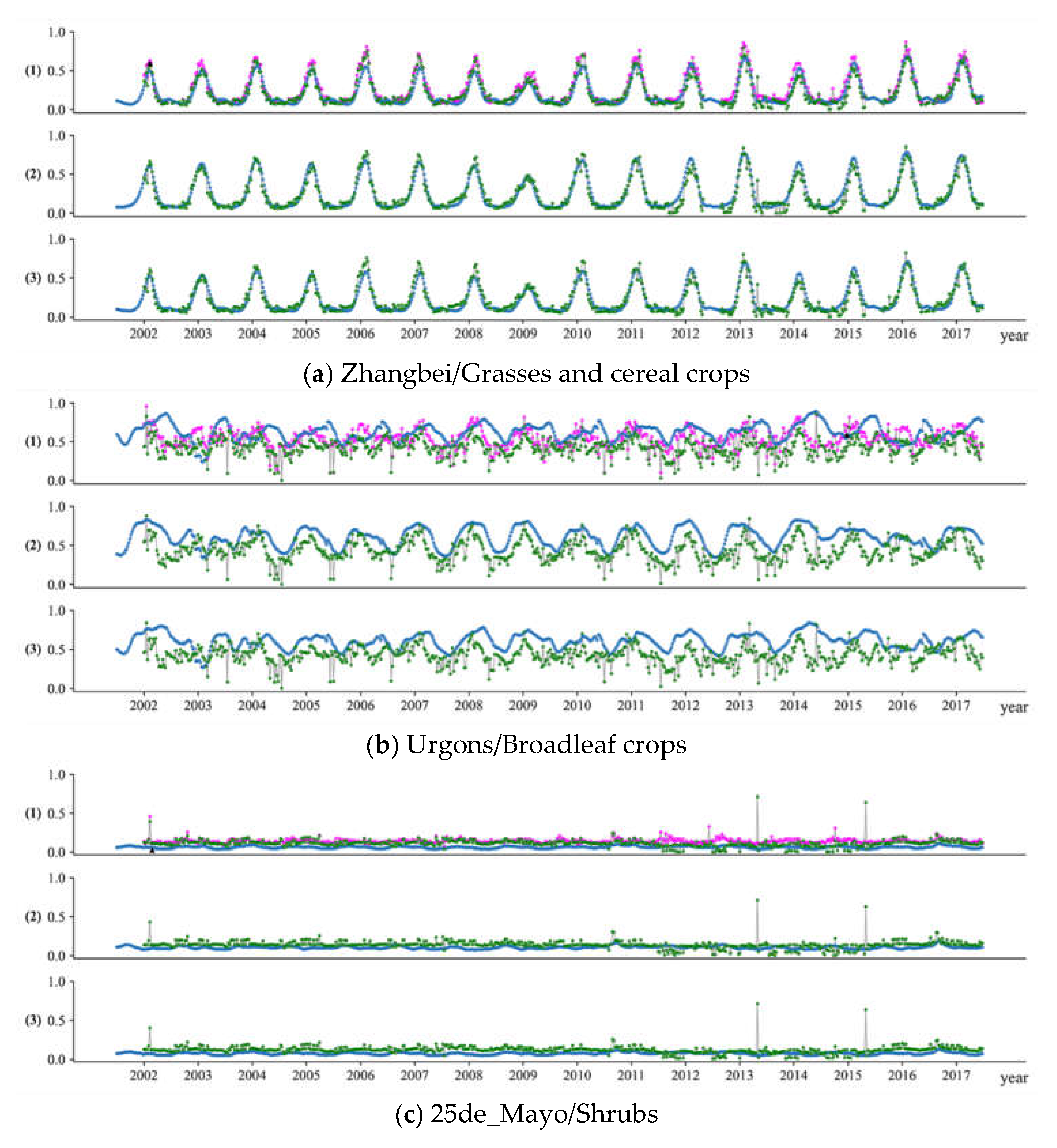
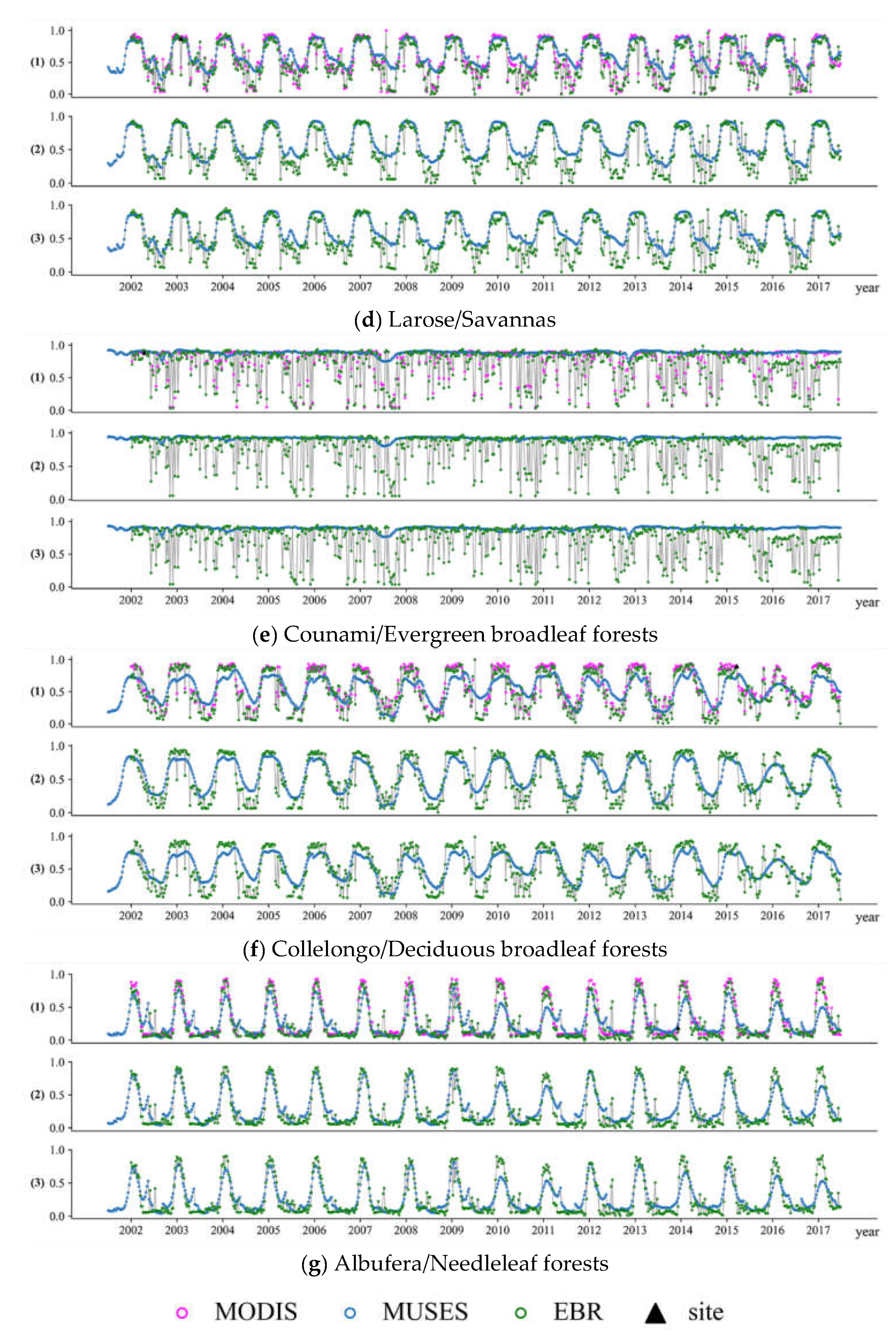

| Site Name | Country | Lat (°) | Lon (°) | Biome Type | DOY/Year | Mean FAPAR |
|---|---|---|---|---|---|---|
| Les_Alpilles * | France | 43.810 | 4.715 | Broadleaf crops | 204/2002 | 0.350 |
| Barrax * | Spain | 39.057 | −2.104 | Broadleaf crops | 194/2003 | 0.083 |
| Camerons * | Australia | −32.598 | 116.254 | Savannas | 63/2004 | 0.455 |
| Concepcion * | Chile | −37.467 | −73.470 | Deciduous broadleaf forests | 9/2003 | 0.801 |
| Counami * | French | 5.347 | −53.238 | Evergreen broadleaf forests | 286/2002 | 0.889 |
| Fundulea * | Romania | 44.406 | 26.583 | Grasses/cereal crops | 151/2003 | 0.347 |
| Gilching * | Germany | 48.082 | 11.320 | Grasses/cereal crops | 199/2002 | 0.714 |
| Gnangara * | Australia | −31.534 | 115.882 | Savanna | 61/2004 | 0.258 |
| Haouz * | Morocco | 31.659 | −7.600 | Shrubs | 71/2003 | 0.295 |
| Laprida * | Argentina | −36.990 | −60.553 | Broadleaf crops | 292/2002 | 0.608 |
| Larose * | Canada | 45.380 | −75.217 | Savanna | 219/2003 | 0.871 |
| Plan-de-Dieu * | France | 44.199 | 4.948 | Broadleaf crops | 189/2004 | 0.245 |
| Sonian * | Belgium | 50.768 | 4.411 | Deciduous broadleaf forests | 174/2004 | 0.921 |
| Sud_Ouest * | France | 43.506 | 1.238 | Broadleaf crops | 189/2002 | 0.634 |
| Turco * | Bolivia | −18.239 | −68.193 | Shrubs | 240/2002 | 0.025 |
| 105/2003 | 0.050 | |||||
| Zhangbei * | China | 41.279 | 114.688 | Grasses/cereal crops | 221/2002 | 0.594 |
| Pshenichne # | Ukraine | 50.077 | 30.232 | Grasses/cereal crops | 134/2013 | 0.218 |
| 166/2013 | 0.721 | |||||
| 196/2013 | 0.871 | |||||
| SouthWest_1 # | France | 43.551 | 1.089 | Grasses/cereal crops | 173/2013 | 0.774 |
| 191/2013 | 0.135 | |||||
| 207/2013 | 0.201 | |||||
| 230/2013 | 0.224 | |||||
| 247/2013 | 0.277 | |||||
| SouthWest_2 # | France | 43.447 | 1.145 | Grasses/cereal crops | 173/2013 | 0.662 |
| 191/2013 | 0.306 | |||||
| 207/2013 | 0.434 | |||||
| 230/2013 | 0.409 | |||||
| 247/2013 | 0.368 | |||||
| Mayo_Alfalfa # | Argentina | −37.907 | −67.746 | Grasses/cereal crops | 40/2014 | 0.376 |
| Mayo_Shurb # | Argentina | −37.939 | −67.789 | Shrubs | 40/2014 | 0.186 |
| Rosasco # | Italy | 45.253 | 8.562 | Grasses/cereal crops | 184/2014 | 0.840 |
| LaReina # | Spain | 37.819 | −4.862 | Grasses/cereal crops | 140/2014 | 0.076 |
| 140/2014 | 0.577 | |||||
| Barrax # | Spain | 39.054 | −2.101 | Broadleaf crops | 149/2014 | 0.674 |
| Albufera # | Spain | 39.274 | −0.316 | needleleaf forests | 158/2014 | 0.186 |
| 175/2014 | 0.441 | |||||
| 196/2014 | 0.648 | |||||
| 219/2014 | 0.724 | |||||
| 234/2014 | 0.816 | |||||
| Pshenichne # | Ukraine | 50.077 | 30.232 | Grasses/cereal crops | 163/2014 | 0.562 |
| 212/2014 | 0.885 | |||||
| Capitanata # | Italy | 41.464 | 15.487 | Grasses/cereal crops | 77/2014 | 0.802 |
| Barrax # | Spain | 39.054 | −2.101 | Broadleaf crops | 145/2015 | 0.489 |
| 203/2015 | 0.354 | |||||
| Pshenichne # | Ukraine | 50.077 | 30.232 | Grasses/cereal crops | 174/2015 | 0.623 |
| 188/2015 | 0.735 | |||||
| 204/2015 | 0.785 | |||||
| Peyrousse # | France | 43.666 | 0.220 | Grasses/cereal crops | 174/2015 | 0.195 |
| Urgons # | France | 43.640 | −0.434 | Broadleaf crops | 174/2015 | 0.585 |
| Creón # | France | 43.994 | −0.047 | Evergreen broadleaf forests | 175/2015 | 0.641 |
| Condom # | France | 43.974 | 0.336 | Grasses/cereal crops | 176/2015 | 0.354 |
| Savenès # | France | 43.824 | 1.175 | Grasses/cereal crops | 176/2015 | 0.262 |
| Collelongo # | Italy | 41.850 | 13.590 | Deciduous broadleaf forests | 189/2015 | 0.893 |
| 266/2015 | 0.896 | |||||
| Capitanata # | Italy | 41.464 | 15.487 | Grasses/cereal crops | 113/2015 | 0.907 |
| UpperTana # | Kenya | −0.772 | 36.974 | Grasses/cereal crops | 68/2016 | 0.544 |
Publisher’s Note: MDPI stays neutral with regard to jurisdictional claims in published maps and institutional affiliations. |
© 2022 by the authors. Licensee MDPI, Basel, Switzerland. This article is an open access article distributed under the terms and conditions of the Creative Commons Attribution (CC BY) license (https://creativecommons.org/licenses/by/4.0/).
Share and Cite
Zheng, Y.; Xiao, Z.; Li, J.; Yang, H.; Song, J. Evaluation of Global Fraction of Absorbed Photosynthetically Active Radiation (FAPAR) Products at 500 m Spatial Resolution. Remote Sens. 2022, 14, 3304. https://doi.org/10.3390/rs14143304
Zheng Y, Xiao Z, Li J, Yang H, Song J. Evaluation of Global Fraction of Absorbed Photosynthetically Active Radiation (FAPAR) Products at 500 m Spatial Resolution. Remote Sensing. 2022; 14(14):3304. https://doi.org/10.3390/rs14143304
Chicago/Turabian StyleZheng, Yajie, Zhiqiang Xiao, Juan Li, Hua Yang, and Jinling Song. 2022. "Evaluation of Global Fraction of Absorbed Photosynthetically Active Radiation (FAPAR) Products at 500 m Spatial Resolution" Remote Sensing 14, no. 14: 3304. https://doi.org/10.3390/rs14143304
APA StyleZheng, Y., Xiao, Z., Li, J., Yang, H., & Song, J. (2022). Evaluation of Global Fraction of Absorbed Photosynthetically Active Radiation (FAPAR) Products at 500 m Spatial Resolution. Remote Sensing, 14(14), 3304. https://doi.org/10.3390/rs14143304






